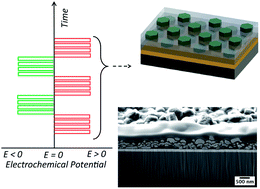One-pot electrosynthesis of multi-layered magnetic metallopolymer nanocomposites†
Abstract
Researchers have been investigating various methodologies for fabricating well-defined, homogenous composites consisting of nanoparticles (NPs) dispersed in a matrix. The main challenges are to prevent particle agglomerations during fabrication and to obtain nanoparticles whose size distribution could be tuned on demand. One of the methods that can provide these features is electrodeposition. We report for the first time the fabrication of a thin magnetic multilayer nanocomposite film by electrodeposition from one bath containing both a monomer and metal salts. Cobalt and cobalt–nickel NPs were deposited on conductive polymer polypyrrole thin films using different electrodeposition potentials and times. Multilayer nanocomposite films were fabricated by subsequent electrodeposition of polymer and nanoparticle layers. Scanning electron microscopy analysis showed that a wide range of NPs (70–230 nm) could be synthesized by manipulating growth potentials and times. The cobalt–nickel NPs were found to contain hexagonal close-packed (hcp) and face-centered cubic (fcc) phases based on X-ray diffraction and selected area electron diffraction. Magnetic measurements proved that both the single and the multi-layered nanocomposites were magnetic at room temperature.


 Please wait while we load your content...
Please wait while we load your content...